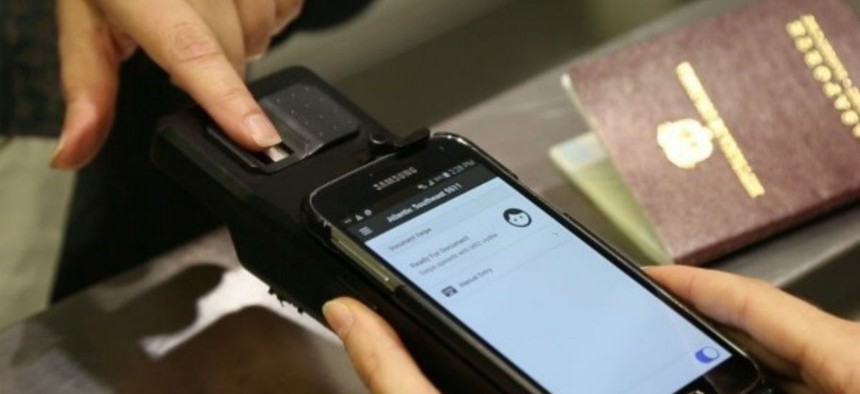Watchdog: DHS' Biometric Exit Tracking Still Needs Work

CBP field-tests a handheld mobile device. CBP
DHS’ previous overstay reports, including the one from fiscal 2015, have been incomplete because of “unreliable collection of departure data."
The Homeland Security Department needs to get better at gathering biometric data from foreign nationals leaving the U.S. if it wants accurate information about those overstaying their visas, a watchdog report suggests.
DHS’ previous overstay reports, including the one from fiscal 2015, have been incomplete because of “unreliable collection of departure data,” according to the Government Accountability Office’s assessment of the Customs and Border Protection’s traveler exit process. DHS planned to issue its 2016 overstays report by February.
Foreign travelers overstaying their visas or expected stays could create “significant homeland security risks,” GAO wrote, noting five out of the 19 Sept. 11 hijackers overstayed their visas.
» Get the best federal technology news and ideas delivered right to your inbox. Sign up here.
CBP has piloted four biometrics exit systems but faces planning, infrastructure and staffing challenges that must be addressed before it can meet its goal of deploying a full-fledged system at one airport by 2018, GAO found. Those pilots include mobile fingerprint readers, facial scanners matching an on-site scan to a database, and facial and iris scans on the Southwest border.
DHS’ time frame for fully deploying a system has gradually shifted. The department planned in July 2014 to have a biometric exit program in 20 airports by 2018; by November 2016, it had revised its goal to 2018 and for just one airport. DHS has cited funding problems as part of this challenge.
Challenges GAO identified in its survey included that mobile fingerprint readers, tested at about 10 airports, need "too much time and manpower to be a solution for biometric exit capabilities” for all flights. For instance, on one flight containing about 75 passengers, six CBP officers took 45 minutes to process the prints.
As of November, CBP had not fully evaluated a pilot conducted at Atlanta’s Hartsfield-Jackson International Airport, which asked travelers to scan boarding passes on a tablet that also took pictures of their faces. The system would match passengers to a database of entry photos.
Another pilot set up outdoors at the Southwest border required travelers to submit passports at kiosks and then undergo facial and iris scans. The system, however, could be stymied at exit points with heavy storms or dust, CBP concluded.
DHS currently has systems to collect biometric data from entrants at air, land and sea ports, but its exit systems still have to catch up, GAO concluded.
The watchdog recommended several steps including the DHS secretary ensures plans for entry and exit biometric data collection are firmer with clearer timelines and cost estimates.
DHS generally agreed with the recommendations.





